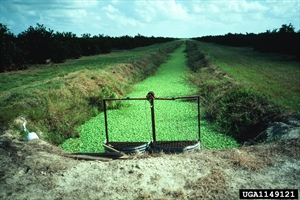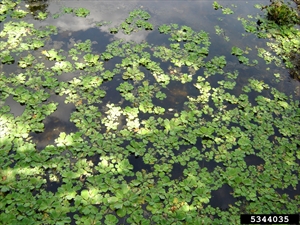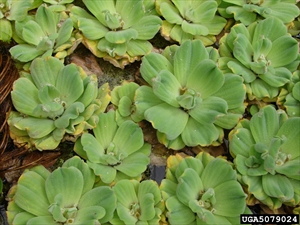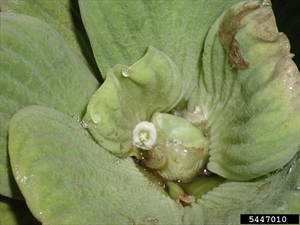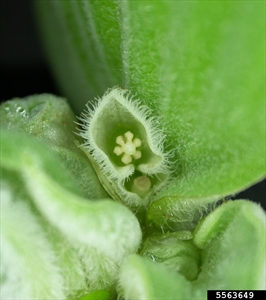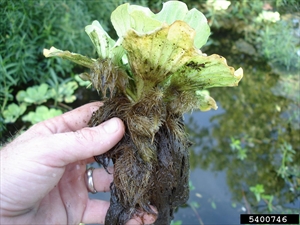Water lettuce; it is also known as Nile cabbage, or floating aroid.
Pacific Pests, Pathogens, Weeds & Pesticides - Online edition
Pacific Pests, Pathogens, Weeds & Pesticides
Water lettuce (456)
Pistia stratiotes. It is a member of the Araceae.
Asia, Africa, North, South and Central America, the Caribbean, Europe, Oceania. It is recorded from Australia, Cook Islands, French Polynesia, Fiji, Guam, New Caledonia, New Zealand, Northern Mariana, Islands, Palau, Solomon Islands, and Vanuatu.
It is thought to have originated in South America. There are suggestion that it is native to tropical Australia, but its occurrence may be explained by ancient use as a medicine and livestock food. It is also native to southeastern USA, and perhaps Africa.
A highly invasive free-floating freshwater weed of lakes, dams, ponds, irrigation channels and slow-moving waterways, of tropical, sub-tropical and warmer temperate regions. Plants develop stolons (underwater stems) and rapidly form dense mats of vegetation on the water surface (Photos 1&2).
Plants have grey-green leaves, in rosettes, occurring singly or connected by short stems, up to 60 cm long. The leaves are often spongy near the base, fan-shaped or slightly spoon-shaped, 2.5-15 cm and 2-8 cm wide, borne on very short stalks (Photo 3). They are covered in soft white hairs that trap air bubbles giving buoyancy. Each leaf has 6-15 characteristic veins (Photo 3). Flowers are not obvious, clustered on small fleshy stalks nearly hidden between the leaves in the middle of the plant (Photo 4). There is a single female flower below and male flowers (Photo 5). The fruit is a many-seeded green berry. Seeds sink to the bottom of the water and, if they make shallow water, germinate under high light. Roots, numerous and feathery (Photo 6).
Spread over short distances occurs by offshoots formed on short, brittle stems (stolons). This can vary depending on the season, with less than 100 to over 1,000 plants per m2. Seed production and dispersal important in some locations, e.g., USA. Spread also possible on fishing nets or boats. Long distant spread overwhelmingly associated with the aquarium trade. Plants 'escape' by being discarded into waterways.
Pistia stratiotes has economic, environmental and social impacts. It can completely cover water bodies, shading out other plants, and removing oxygen as it decomposes, disrupting all life in and on the water. It clogs waterways preventing river travel, blocks irrigation canals, destroys rice paddies and ruins fishing grounds. It affects hydro-electricity production as its vast mats clog the turbines. In some countries, it harbours disease-carrying mosquitoes.
The weed does have some useful characteristics, such as, medicinal properties and a fodder for cattle and pigs. However, these uses cannot compensate for its negative impacts as a weed.
BIOSECURITY
There is a high risk of introducing this weed. Countries not yet infested should consider all likely pathways for entry, and apply quarantine measures accordingly. Particular attention should be given to the risks associated with the plant as an ornamental and its trade as an aquarium plant. It can be purchased via the internet.
Pistia. stratiotes is on the Global Invasive Species Database (2020) of information about alien and invasive species that negatively impact biodiversity, managed by the Invasive Species Specialist Group of the IUCN Species Survival Commission. It is a noxious weed in South Africa and parts of the USA - prohibited plant that must be controlled - they serve no economic purpose and possess characteristics that are harmful to humans, animals or the environment.
BIOLOGICAL CONTROL
Adults and larvae of the South American weevil, Neohydronomous affinis, feed on Pistia stratiotes leaves. The weevil has been released in Africa, Papua New Guinea, and the USA. The larvae of the moth, Spodoptera pectinicornis, has been reported to control the weed in Thailand, where it is said to have replaced herbicides. Three species of Argentinorhynchus weevils also have potential.
CULTURAL CONTROL
- Physical & Mechanical
- Check water nutrient levels: those of nitrogen and phosphorous, should be reduced, e.g., it is important to prevent sewage entering waterways, as well as the run-off from agricultural lands.
- Use floating booms to prevent movement of weed into waterways.
- Use manual removal with rakes, fishing nets or, if funds allow, mechanical harvesting. It is then either dried on shore (preferably a dry place) for at least 2 months to ensure it dies, or chopped up by machine and sprayed on the water. (If the weed is returned to water after chopping, check that it does not de-oxygenate the water when decomposing.)
CHEMICAL CONTROL
In Australia: glyphosate; 2,4-D (acid); carfentrazone-ethyl, are registered (or under permit) for use against water lettuce. In Fiji, MCPA.
IPM programs recommend i) release of Neohydronomous affinis, ii) use of selected herbicide in strips leaving the weevil to concentrate on the unsprayed mats; and iii) removal of dead plants to prevent reduced water quality caused by the rotting vegetation.
--------------------
Note, in the EU, and approval to use glyphosate ends in December 2022; its use after that date is under discussion.
____________________
When using a pesticide, always wear protective clothing and follow the instructions on the product label, such as dosage, timing of application, and pre-harvest interval. Recommendations will vary with the crop and system of cultivation. Expert advice on the most appropriate herbicides to use should always be sought from local agricultural authorities.
AUTHORS Grahame Jackson & Aradhana Deesh
Adapted from Water lettuce (Pistia stratiotes) (2018) Weeds of SE Qld and Northern NSW. Lucidcentral. (https://www.lucidcentral.org/editors-pick-animal-and-plant-identification-keys/key-to-weeds-of-se-qld-and-northern-nsw); and additional information from CABI (2019) Pistia stratiotes (water lettuce). Invasive Species Compendium. (https://www.cabi.org/isc/datasheet/41496#tosummaryOfInvasiveness); and Pistia stratiotes L., Araceae (2013) Pacific Island Ecosystems at Risk (PIER). (http://www.hear.org/pier/species/pistia_stratiotes.htm); and from Pistia (2020) Wikipedia. (https://en.wikipedia.org/wiki/Pistia). Photo 1 USDA APHIS PPQ - Oxford, North Carolina , USDA APHIS PPQ, bugwood.org. Photo 2 Karen Brown, University of Florida, Bugwood.org. Photo 3 Troy Evans, Great Smoky Mountains National Park, Bugwood.org. Photo 4 Leslie J. Mehrhoff, University of Connecticut, Bugwood.org. Photo 5 Shaun Winterton, Aquarium and Pond Plants of the World, Edition 3, USDA APHIS PPQ, Bugwood.org. Photo 6 Graves Lovell, Alabama Department of Conservation and Natural Resources, Bugwood.org.
Produced with support from the Australian Centre for International Agricultural Research under project HORT/2016/185: Responding to emerging pest and disease threats to horticulture in the Pacific islands, implemented by the University of Queensland, in association with the Pacific Community and Koronivia Research Station, Ministry of Agriculture, Fiji.
